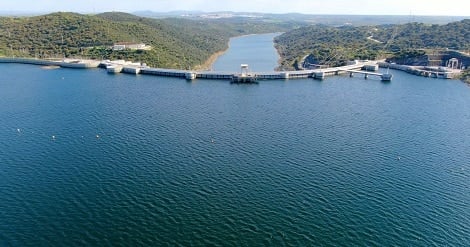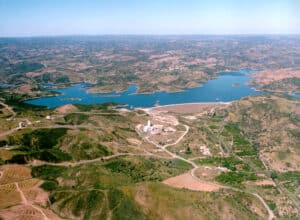Alentejo dam is one of Europe’s largest
After recent weeks of rain, the Alqueva dam, in the Alentejo, is half a metre from its full storage level, level 152.
Like a number of other smaller dams, the exceptionally wet weather has brought low levels up exponentially.
Some dams are already ‘letting out water’. In Alqueva’s case, the situation “doesn’t pose any problems”, José Pedro Salema, president of the Beja-based Alqueva Development and Infrastructure Company (EDIA)company that manages it, told Lusa today
Level 152 is still “not Alqueva’s maximum level, as the infrastructure is prepared to support loads up to level 153”.
In other words, he stressed, “one metre more than this full storage level, which we call maximum flood level”.
Given this situation, and “out of prudence”, EDIA and EDP, the concessionaire of the Alqueva hydroelectric power station, have agreed to avoid pumping water from the dam and to use the turbine method for energy production, which “removes a lot of water” from the reservoir.
“I would remind you that the four reversible groups (of the hydroelectric power station] at Alqueva in turbination use 800 cubic metres (m3) per second [of water] and only when the inflows are higher than this order of magnitude is the flow capacity that turbination allows exhausted,” explained Salema.
At the same time, at 21:00 on Wednesday, EDIA began discharging the Pedrogão dam in the district of Beja, which is located 23 kilometres downstream Alqueva.
In a statement sent out today, the management company said that these discharges “will cause a temporary increase in the flow of the River Guadiana downstream of the Pedrógão dam”, in the municipality of Vidigueira, in the “order of 280 m3/second”.
“For this reason, we are warning riverside populations, fishermen, farmers and other users in the area to take the necessary precautions,” added the company, noting that “the time until there is an increase in the flow in Mértola may be longer than 18 hours.”
According to José Pedro Salema, this is a “perfectly normal, ordinary situation that doesn’t pose any problems”, rejecting, for the time being, the possibility of water being discharged from the Alqueva reservoir itself.
“I know the public would like to see it, but when that happens, the water is losing its potential energy for no benefit and it’s much more interesting to pass it through the turbine and generate electricity that we then use in our homes,” he explained.
If necessary, Salema said “there are many ways of getting water out of that reservoir that are perfectly operational”, namely three surface spillways, two mid-bottom spillways and a bottom spillway.
And for those that are interested, the rain is set to continue for at least another week!


























